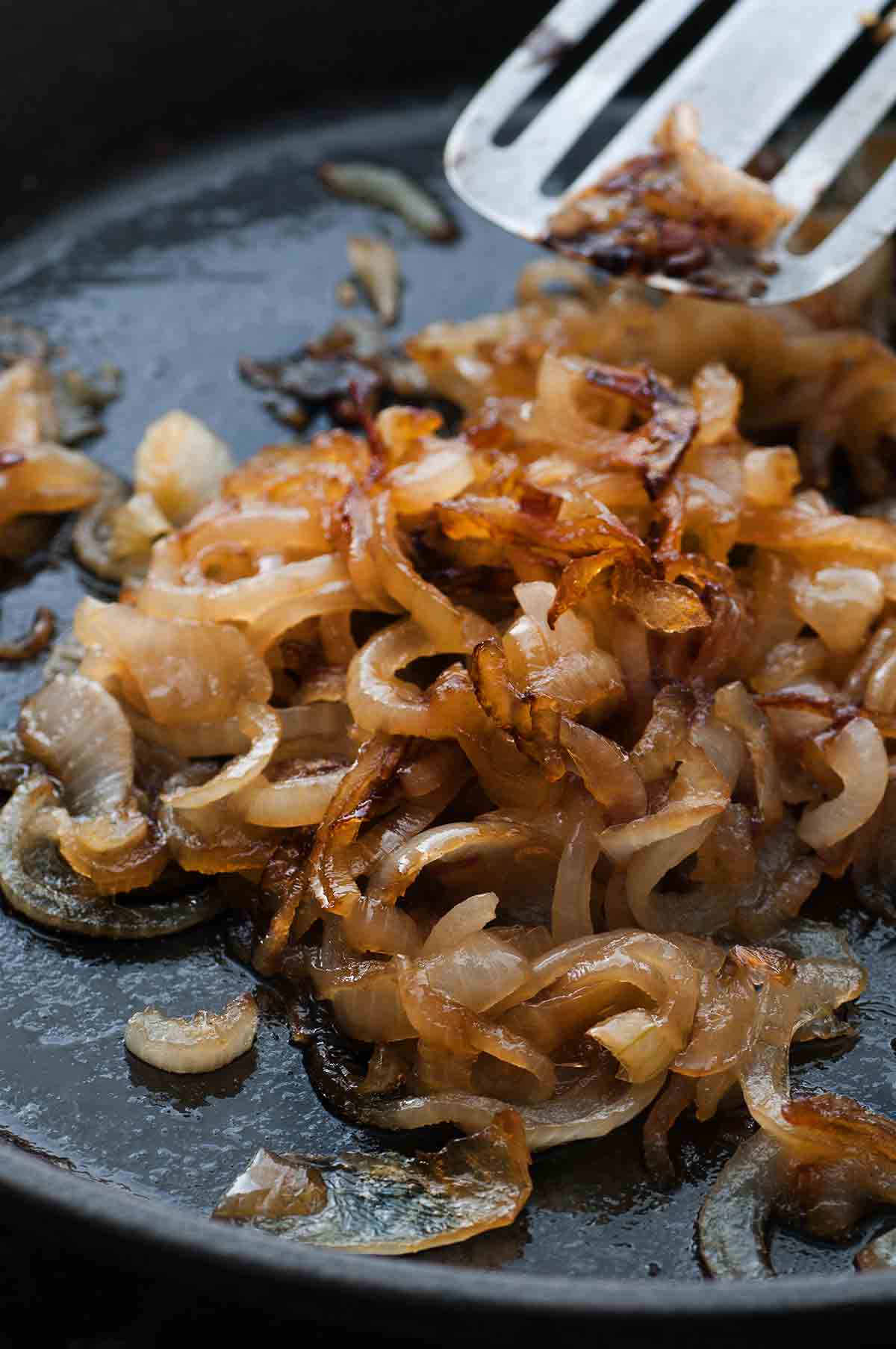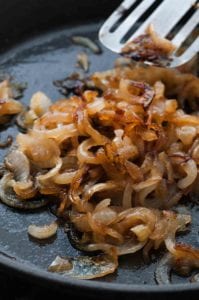
We know, we know. You’re busy. You’re impatient. You’re rushing cuz you’ve got places to go, people to see, babies to kiss. And you’re thinking you can’t possibly afford to spend an hour of your life waiting for onions to caramelize. We think you can. Taste a spoonful of this and then tell us it ain’t worth it.–Renee Schettler Rossi

How To Caramelize Onions
Ingredients
- 2 tablespoons olive or vegetable oil
- 4 medium or 3 large onions, halved and sliced as thinly as possible
- 1 1/2 teaspoons kosher salt
- 1 teaspoon freshly ground black pepper
- 2 teaspoons finely chopped fresh thyme, (optional)
Instructions
- In a large skillet, heat the oil over medium heat. Add the onions and cook, tossing and stirring occasionally, for 15 to 20 minutes, or until softened. Reduce the heat to low and continue cooking, stirring occasionally, for another 50 to 60 minutes, or until the onions are completely soft and caramelized. They will look dark brown and mushy.
- Remove the skillet from the heat and add the salt, pepper, and thyme, if using, and stir well. Go ahead and use your caramelized onions immediately or stash them in an airtight container in the fridge for up to 1 week.
Notes
How To Make Caramelized Onions In Advance
Why not caramelize a BIG batch of onions when you’re in the kitchen when it’s no big whoop to stay close to the stovetop and show the wilting alliums some love by stirring them on occasion. Maybe a random Tuesday night while you’re making dinner. Or a Sunday morning while you’re flipping flapjacks. Then cram the caramelized onions in a jar or other resealable container, stash them in the fridge for up to a few days, and you’ve got magic waiting to happen. Slather them on a sandwich. Strew them on savory tarts. Toss them with pasta and blue cheese. Or sneak them onto breakfast pizzas. You won’t be sorry.
Nutrition
Nutrition information is automatically calculated, so should only be used as an approximation.
Recipe Testers’ Reviews
Here’s a great use of +/- 60 minutes. Even if the end result wasn’t magnificent, there is the aroma of 60 minutes of deliciously fragrant onions all through the house. But the end result is magnificent.
Because I was making these for a dish I felt would be plenty salty, I did not salt at the end, though I did pepper generously. If I’d have been smarter, I would have made a double batch, one for the recipe I was working on and one to stash in the fridge for later.
As for timing, my onions were well softened after the full 20 minutes, and took 45 more minutes to become dark brown and mushy. I probably futzed with the onions more than necessary during the hour, but there is still plenty of time to keep these going while attending to something else, or to relax for an hour while allowing the onions to take their time browning and softening.
They never even had a moment to cool before I used them in another recipe. If I didn’t have a plan for them, I would salt and also use the optional fresh thyme.
Select a Tester
Low and slow. That’s the sorta flame you need when coaxing out the complex sweetness of caramelized onions. Not this 20 minutes business. (I once got into a heated argument with a colleague at a newspaper about what exactly constituted properly caramelized onions. Unsatisfied with our stalemate, I ran to my rolodex of chefs and he ran to his, and the duel was on. Needless to say, no chef in his or her right mind would agree that 20 minutes was sufficient.) This technique and timing does it right.











Where my husband is from India. They make a version of caramelized onions called “birista.” The onions are cooked much the same way but the slight sweetness of the small purple onions used in India gives them an extra zip (in my opinion). Birista is used to top savory dishes from pulau to biryani to roti. If you’ve ever wondered what makes up the rich brown gravy in many Indian mutton & lamb dishes it is usually birista ground with a few spices & a bit of yoghurt, then cooked again with the meat. The north Indian traditional dishes Mutton Do Pyaza (goat with onions twice), Nihari Gosht, & Mutton Belliram are typically made this way. A friend of mine (whom is also an excellent photographer) did a post on her gorgeous blog on the preparation of birista.
Beatrix, thank you for all that wonderful information–and the link to your friend’s blog. I think it will come in handy for our readers.
Kenji Alt-Lopez has developed a 15-minute caramelized onion (I think there’s even video) that’s 90% as good as sauteing for an 60 minutes. For my part, caramelized onions tastes even better with a tablespoon of balsamic vinegar added at the end of cooking.
ARNell, it’s interesting that even Kenji admits, “…the realization that as good as the onions are using this method, they still aren’t as good as traditionally cooked onions. I tasted them blind a few times and missed a bit of the sweetness and subtle flavor from old-fashioned caramelized onions.” I don’t think there is any substitute for properly cooked onions. As he says they’re good in a pinch. I do agree that a splash of balsamic vinegar is a lovely addition.
I’m in Uruguay at the moment and had a terrific caramelized onion–goat-cheese tart. The onions were cooked with red wine, which adds a fantastic flavor.
Don’t forget Barbara Kafka’s recipe from her cookbook Microwave Gourmet.
Thanks for the reminder about Barbara’s book, linda. Many paths to the same destination, right?